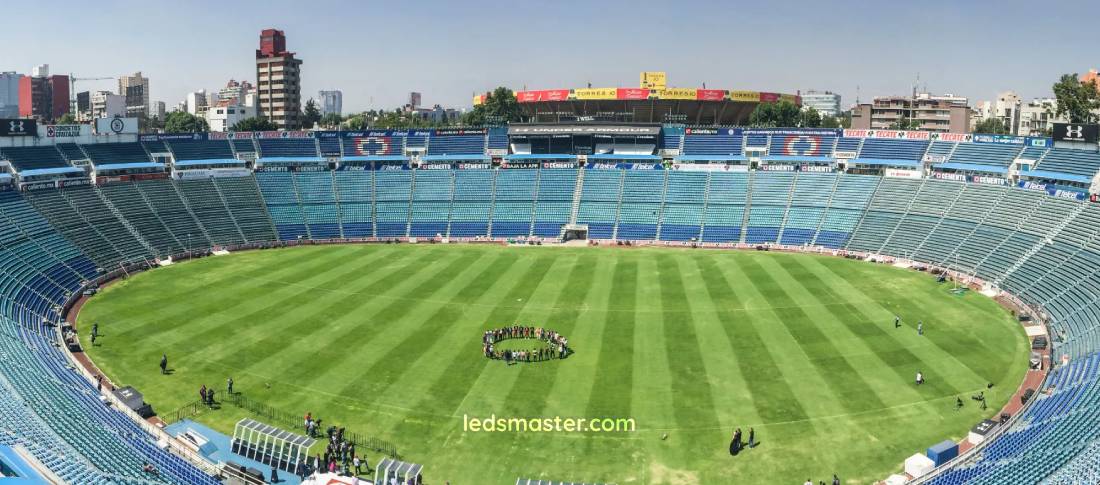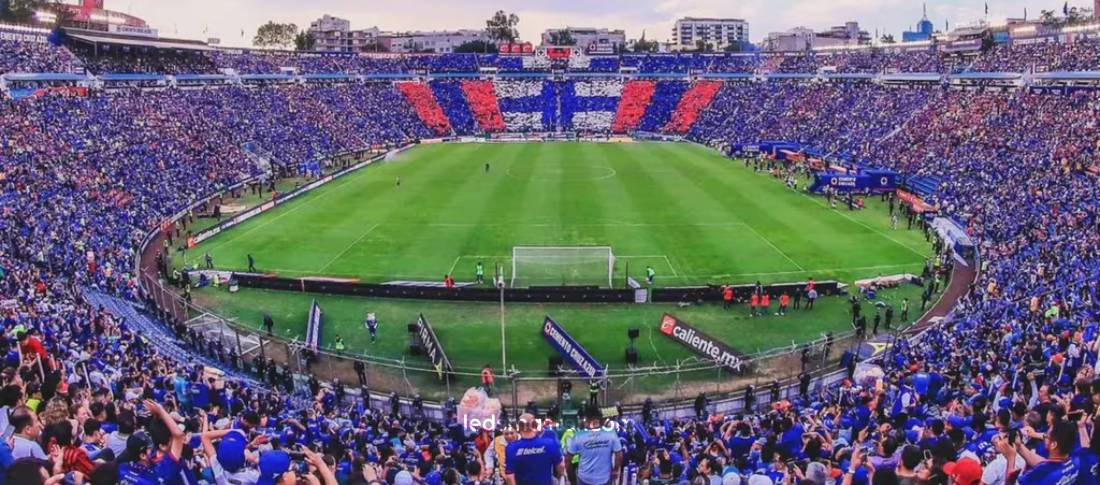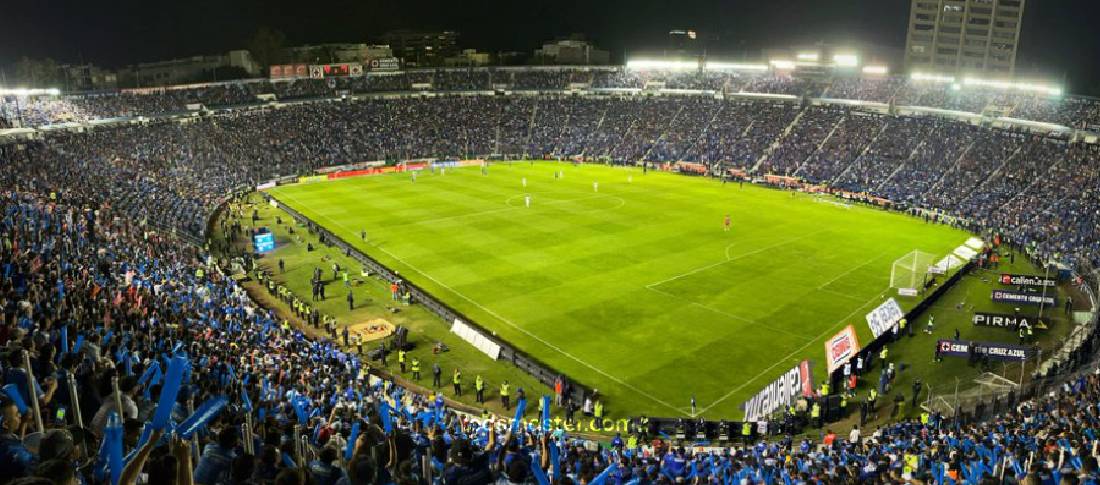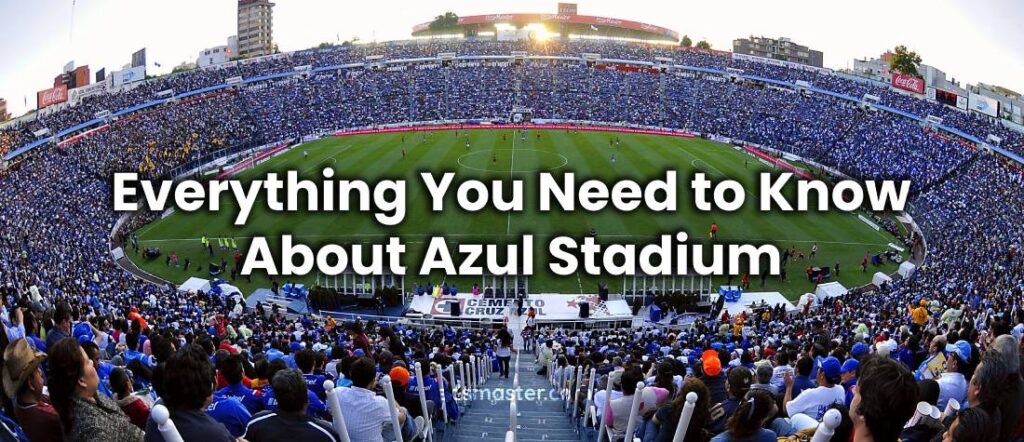Estadio Ciudad de los Deportes, or Azul Stadium, is a key venue in Mexico City, renowned for hosting a diverse range of events including sports, concerts, and community activities. Opened in 1966, the stadium has seen significant upgrades over the decades to enhance its facilities and infrastructure. This article explores the stadium’s history, design, and amenities, with a special focus on its lighting system, particularly the transition to LED technology, highlighting how these advancements have improved the stadium’s functionality and environmental sustainability. Today, Azul Stadium remains a vital hub for major events and continues to adapt to modern needs while preserving its historical significance.

Table of Contents
ToggleHistorical Overview
The Origins and Construction
The construction of Estadio Ciudad de los Deportes, which began in the late 1960s, was a pivotal project spearheaded by the renowned Mexican architect Pedro Ramírez Vázquez. His vision for the stadium was to create a facility that not only met the needs of the 1968 Summer Olympics but also provided a lasting venue for various future events. Vázquez’s design blended functionality with modern aesthetics, showcasing a circular bowl structure that ensured excellent sightlines for spectators and a versatile space adaptable to different types of events.
The stadium was strategically located to serve as a central hub for major sporting and cultural events in Mexico City. Its grand opening was a celebrated occasion, marking a significant milestone in the country’s architectural and sports history. The stadium was hailed for its innovative design and was considered a landmark achievement in modern architecture at the time. The initial success of the stadium was underpinned by its ability to host international sporting events, setting a high standard for future venues in the region.
Evolution Through the Decades
Since its opening, Azul Stadium has undergone a series of transformations to keep pace with evolving standards and technological advancements. The initial phase of renovations focused on enhancing spectator comfort and safety. This included the installation of more comfortable seating, improved restroom facilities, and expanded concession areas to accommodate growing crowds and meet contemporary expectations.
As the stadium continued to host a variety of high-profile events, such as international soccer matches, major concerts, and significant community gatherings, it became clear that ongoing updates were essential to maintain its competitive edge. Subsequent renovations addressed the need for modern amenities, including upgraded lighting systems that improved the quality of both the spectator experience and broadcast capabilities. The integration of advanced lighting technologies, such as LED systems, marked a significant step in enhancing the stadium’s functionality and reducing operational costs.
The stadium’s ability to adapt over the decades has solidified its reputation as a premier event venue. Its evolution reflects not only changes in architectural and technological trends but also its role in the cultural and social fabric of Mexico City. The stadium has become more than just a venue; it is a symbol of local pride and an integral part of the community. The hosting of various significant events has reinforced its status as a central location for major cultural and sporting activities, ensuring its relevance in an ever-changing landscape.

Architectural Design
Unique Design Features
Azul Stadium is renowned for its distinctive architectural design, particularly its circular bowl structure that maximizes visibility and enhances the spectator experience. This design ensures that every seat offers an unobstructed view of the field, creating an immersive and engaging atmosphere for attendees. The stadium’s compact seating arrangement, with steeply raked tiers, brings fans closer to the action and amplifies the venue’s dynamic environment. Additionally, the striking blue color scheme—reflected in the seating, exterior, and branding elements—contributes to the stadium’s iconic identity and reputation, making it instantly recognizable and synonymous with its vibrant character.
Another standout feature is the innovative roof structure, which provides coverage for spectators while maintaining an open and airy feel. This element balances functionality and aesthetics, ensuring a comfortable viewing experience regardless of the weather. The use of concrete in the stadium’s construction was groundbreaking at the time, showcasing a forward-thinking approach that contributed to its iconic status. The bold circular shape not only serves practical purposes but also enhances the stadium’s visual impact, solidifying its place as a landmark in Mexico City’s architectural landscape.
Seating Arrangement and Accessibility
Azul Stadium’s seating arrangement is expertly designed to accommodate a diverse array of events and audiences, with a capacity of approximately 30,000. The stadium features a combination of lower and upper tiers that efficiently use space and offer various seating options, enhancing comfort and visibility. This design ensures that large crowds are managed effectively while providing an optimal viewing experience from almost any seat. The layout’s steep gradient positions spectators close to the field or stage, intensifying the event experience and contributing to the stadium’s appeal.
Accessibility is a core element of the stadium’s design, incorporating ramps, elevators, and designated seating areas to ensure inclusivity for all visitors, including those with disabilities. This commitment to accessibility underscores the stadium’s dedication to providing an equitable experience for every patron. The overall design, with its innovative features and practical considerations, highlights Azul Stadium’s status as a landmark venue. Its unique circular shape, striking color scheme, and advanced roof structure, combined with thoughtful seating arrangements and accessibility, reinforce its role as a premier location for major events and a cherished part of Mexico City’s architectural heritage.

Facilities and Amenities
Concessions and Dining Options
Azul Stadium offers a wide array of food and beverage concessions, catering to diverse tastes and preferences. From traditional snacks like nachos and hot dogs to more gourmet options such as artisanal sandwiches and specialty beverages, the stadium ensures that attendees have a variety of high-quality dining choices available during events. Recent upgrades have introduced sustainable food options, including locally sourced ingredients and eco-friendly packaging, aligning with modern consumer preferences for healthier and environmentally conscious choices. This commitment to diverse and sustainable dining options not only enhances the overall spectator experience but also reflects the stadium’s dedication to meeting contemporary standards and environmental considerations.
VIP and Hospitality Areas
The VIP and hospitality areas at Azul Stadium are designed to offer a premium experience for guests seeking an elevated level of comfort and service. These exclusive zones feature plush, comfortable seating arrangements and a range of gourmet dining options, ensuring that premium guests enjoy a superior level of luxury and convenience. The incorporation of advanced lighting solutions in these areas contributes to a visually appealing and sophisticated atmosphere, enhancing the overall ambiance. These areas are meticulously designed to cater to the specific needs of high-end patrons, offering exceptional service and amenities that elevate their event experience. This attention to detail reinforces the stadium’s reputation for providing a high-quality and memorable experience for all guests.
Restrooms and Other Services
Strategically placed modern restroom facilities throughout Azul Stadium are designed to provide convenience and comfort for all attendees. These facilities are equipped with the latest amenities to ensure cleanliness and accessibility, reflecting a commitment to high standards of hygiene and user experience. In addition to restrooms, the stadium offers various other essential services, including first aid stations and merchandise shops, enhancing the overall visitor experience. Recent upgrades have focused on improving the efficiency and accessibility of these services, ensuring they meet contemporary standards and cater to the needs of all visitors. This comprehensive approach to facilities and amenities underscores the stadium’s dedication to providing a seamless and enjoyable experience for everyone.
Lighting System
Transition to LED Technology
The transition to LED lighting at Azul Stadium marks a major upgrade in its infrastructure, delivering numerous advantages. LED technology has significantly improved energy efficiency, which translates to lower electricity consumption and reduced operational costs. This modern lighting solution provides superior light quality with enhanced brightness and color accuracy, creating a more dynamic and visually appealing environment for events. Furthermore, LED lights require less maintenance compared to traditional lighting systems due to their longer lifespan, which minimizes downtime and associated costs. The move to LED not only modernizes the stadium’s facilities but also aligns with broader environmental sustainability goals, reflecting a commitment to reducing the stadium’s carbon footprint and supporting eco-friendly practices.
Impact on Events
The installation of LED lighting has profoundly improved the event experience for both participants and spectators at Azul Stadium. The enhanced brightness and color precision of LED lights create a more vibrant and immersive atmosphere, whether the stadium is hosting a high-stakes sports match, a major concert, or a community gathering. The superior lighting quality also benefits television broadcasts and live streams, offering clearer and more dynamic visuals that enhance viewer engagement and expand the stadium’s reach. These lighting upgrades have elevated the overall quality of events held at the venue, making it more attractive for high-profile events and contributing to a more enjoyable and memorable experience for everyone involved.
Environmental Benefits
The environmental impact of transitioning to LED lighting at Azul Stadium has been notably positive. LEDs are more energy-efficient than traditional lighting options, which results in lower overall energy consumption and a decrease in greenhouse gas emissions. This reduction in energy use supports the stadium’s sustainability initiatives and helps mitigate its environmental impact. Additionally, the extended lifespan of LED lights reduces the frequency of replacements, leading to less waste and fewer resources needed for maintenance. By adopting LED technology, the stadium has taken a significant step towards enhancing its environmental stewardship, demonstrating a commitment to sustainability while maintaining high standards of performance and efficiency.
Conclusion
Azul Stadium, has evolved from its historic origins into a modern icon of Mexico City. Since its opening in 1966, the stadium has undergone significant transformations, maintaining its relevance through extensive renovations and updates. The distinctive architectural features, including its circular design and striking blue color scheme, have established it as a landmark venue. Recent advancements, particularly the shift to LED lighting, have further enhanced the stadium’s functionality, offering improved energy efficiency and a superior event experience. Azul Stadium continues to play a central role in the cultural and sporting life of the city, embodying a blend of historical significance and modern innovation.

